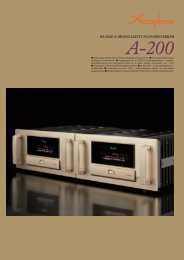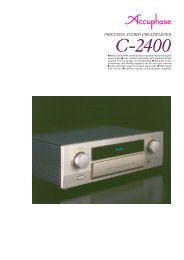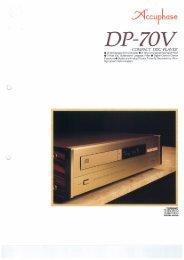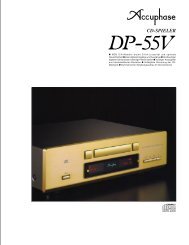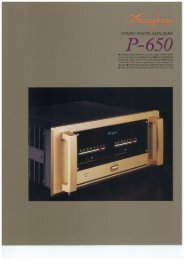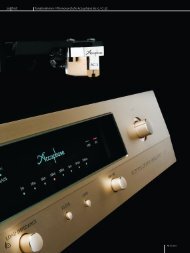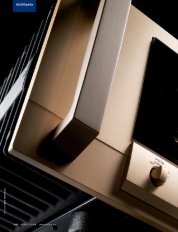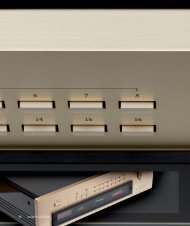m Digital power amplifier with totally separate six-channel ...
m Digital power amplifier with totally separate six-channel ...
m Digital power amplifier with totally separate six-channel ...
You also want an ePaper? Increase the reach of your titles
YUMPU automatically turns print PDFs into web optimized ePapers that Google loves.
m <strong>Digital</strong> <strong>power</strong> <strong>amplifier</strong> <strong>with</strong> <strong>totally</strong> <strong>separate</strong> <strong>six</strong>-<strong>channel</strong> configuration<br />
m Output <strong>power</strong> 200 watts × 6 into 4 ohms, 150 watts × 6 into 8 ohms<br />
m Bridged operation further increases output to 450 watts × 3 into 4 ohms<br />
and 420 watts × 3 into 8 ohms m Instrumentation <strong>amplifier</strong> principle for fully<br />
balanced signal paths m Large 820 VA toroidal transformer m Balanced inputs<br />
m Three large analog <strong>power</strong> meters m Large-size speaker terminals
Six-<strong>channel</strong> digital <strong>power</strong> <strong>amplifier</strong> – Six <strong>totally</strong> <strong>separate</strong> <strong>power</strong> units<br />
<strong>with</strong> identical performance. Discrete delta-sigma type digital <strong>power</strong><br />
units ensure extremely low noise. Large 820 VA toroidal transformer<br />
and large filtering capacitors provide ample muscle: 200 watts × 6<br />
into 4 ohms or 150 watts × 6 into 8 ohms. Bridged mode allows<br />
upgrade to 3-<strong>channel</strong> <strong>amplifier</strong> <strong>with</strong> 420 watts × 3 into 8 ohms.<br />
The PX-650 represents a successful blend of digital<br />
audio technology <strong>with</strong> Accuphase's rich expertise<br />
in the field of analog <strong>power</strong> <strong>amplifier</strong>s. The result is<br />
a <strong>six</strong>-<strong>channel</strong> digital <strong>power</strong> <strong>amplifier</strong> ideally suited<br />
for high-end home theater systems. Because <strong>six</strong><br />
identical high-efficiency <strong>power</strong> units operating in<br />
digital mode are used, all <strong>channel</strong>s provide the same<br />
excellent sound quality. The PX-650 can drive any<br />
kind of speaker <strong>with</strong> ease and authority, creating a<br />
spacious surround sound stage <strong>with</strong> pinpoint imaging<br />
and impressive dynamics. Thanks to its high<br />
efficiency, the digital circuitry keeps thermal energy<br />
generation low, making it possible to reconcile high<br />
output <strong>power</strong> levels <strong>with</strong> compact unit dimensions.<br />
This is especially welcome in multi-<strong>channel</strong> systems<br />
for home theater applications.<br />
The capability for high <strong>power</strong> and small size has been<br />
a recognized advantage of the digital principle for<br />
<strong>power</strong> <strong>amplifier</strong>s, but performance and sound quality<br />
related problems had to be overcome before<br />
adoption in a high-end audio product was possible.<br />
The PX-650 represents a breakthrough in the field.<br />
It is the result of a highly focused step-by-step<br />
approach to identify and solve these pertinent<br />
problems. Circuit topology as well as the selection<br />
of components and materials are based on extensive<br />
listening tests. The aim was nothing less than to<br />
realize pure audio quality of the highest standard<br />
while making best use of the digital approach. In<br />
performance as well as in sound quality, the PX-650<br />
is a case in point. The digital switching principle<br />
boasts extremely low internal losses. The <strong>power</strong><br />
supply is not called upon to provide superfluous<br />
energy, which in turn keeps <strong>power</strong> consumption and<br />
therefore operation temperatures low. A <strong>power</strong><br />
supply rated for the same capacity in an analog<br />
<strong>amplifier</strong> would be much less <strong>power</strong>ful. The knowhow<br />
accumulated by Accuphase in the analog field<br />
is also in evidence in the PX-650, as exemplified by<br />
its large toroidal transformer. By combining the<br />
advantages of the digital principle, namely high<br />
<strong>power</strong> and low current consumption, <strong>with</strong> solid<br />
engineering and sophisticated design expertise,<br />
Accuphase has opened up a new chapter in digital<br />
audio.<br />
Balanced signal transmission <strong>with</strong> instrumentation<br />
amp configuration<br />
The PX-650 features the highly advanced<br />
"instrumentation <strong>amplifier</strong>" principle whereby all<br />
signal paths from the inputs to the <strong>power</strong> amp stage<br />
are fully balanced. Ideal signal transmission<br />
conditions result in excellent CMRR (common mode<br />
rejection ratio) and minimal distortion. Another<br />
significant advantage is that external noise and other<br />
external influences are virtually shut out. The result<br />
is a drastic improvement in operation stability and<br />
reliability.<br />
+ INPUT +<br />
Signal input stage<br />
–<br />
GAIN CONTROL<br />
CIRCUIT<br />
NFB<br />
NETWORK<br />
NFB<br />
NETWORK<br />
Power amp stage<br />
DIGITAL<br />
POWER<br />
AMP.<br />
OUTPUT<br />
n Six digital <strong>power</strong> amp units <strong>with</strong> identical performance allow<br />
configuring a superb 5.1 <strong>channel</strong> surround system using a single<br />
component<br />
With all <strong>six</strong> <strong>channel</strong>s operating, the PX-650 delivers 200 watts × 6 into 4<br />
ohms and 150 watts × 6 into 8 ohms. In 2-<strong>channel</strong> mode, the unit becomes<br />
even more <strong>power</strong>ful, <strong>with</strong> 250 watts × 2 into 4 ohms and 170 watts × 2 into<br />
8 ohms.<br />
n Bridged operation allows upgrade to a high-output 3-<strong>channel</strong><br />
<strong>amplifier</strong><br />
The two <strong>channel</strong>s in all three blocks can be run in bridged<br />
mode, resulting in a full 450 watts × 3 into 6 ohms and 420<br />
watts × 3 into 8 ohms. This represents top performance<br />
<strong>with</strong> <strong>power</strong> to spare.<br />
n Power supply features large toroidal transformer and<br />
ample filtering<br />
The toroidal <strong>power</strong> transformer of the PX-650 is rated for<br />
820 VA, and filtering is provided by two aluminum electrolytic<br />
capacitors <strong>with</strong> ample 33,000 µF rating.<br />
n Gain selector provides 6 dB increase in normal or<br />
bridged operation<br />
n Mode selector allows easy implementation of<br />
bridged operation<br />
n Balanced inputs highly resistant to externally<br />
induced noise<br />
n Three analog <strong>power</strong> meters <strong>with</strong> direct reading scale<br />
A meter selector button allows use of the meters for all <strong>six</strong><br />
<strong>channel</strong>s. On/off switching for meter operation and<br />
illumination is also provided.<br />
n Front-panel input selector button allows easy choice<br />
of balanced and unbalanced inputs<br />
n Large-size speaker terminals compatible <strong>with</strong><br />
Y lugs and banana plugs<br />
LEFT<br />
INPUTS<br />
A<br />
C<br />
D<br />
RIGHT<br />
B<br />
BALANCED<br />
INPUT<br />
UNBALANCED<br />
INPUT<br />
BALANCED<br />
INPUT<br />
UNBALANCED<br />
INPUT<br />
BALANCED<br />
INPUT<br />
UNBALANCED<br />
INPUT<br />
BALANCED<br />
INPUT<br />
UNBALANCED<br />
INPUT<br />
BALANCED<br />
INPUT<br />
UNBALANCED<br />
INPUT<br />
BALANCED<br />
INPUT<br />
UNBALANCED<br />
INPUT<br />
INPUT<br />
SELECTOR<br />
INPUT<br />
SELECTOR<br />
INPUT<br />
SELECTOR<br />
MODE<br />
SELECTOR<br />
MODE<br />
SELECTOR<br />
MODE<br />
SELECTOR<br />
GAIN<br />
CONTROL<br />
GAIN<br />
CONTROL<br />
GAIN<br />
CONTROL<br />
GAIN<br />
CONTROL<br />
GAIN<br />
CONTROL<br />
GAIN<br />
CONTROL<br />
+<br />
AMP.<br />
–<br />
–<br />
AMP.<br />
+<br />
+<br />
AMP.<br />
–<br />
–<br />
AMP.<br />
+<br />
+<br />
AMP.<br />
–<br />
–<br />
AMP.<br />
+<br />
+<br />
AMP.<br />
–<br />
–<br />
AMP.<br />
+<br />
+<br />
AMP.<br />
–<br />
–<br />
AMP.<br />
+<br />
+<br />
AMP.<br />
–<br />
–<br />
AMP.<br />
+<br />
NFB<br />
NFB<br />
NFB<br />
NFB<br />
NFB<br />
NFB<br />
NFB<br />
NFB<br />
NFB<br />
NFB<br />
NFB<br />
NFB<br />
Large toroidal <strong>power</strong> transformer<br />
Meter selector buttons<br />
DIGITAL<br />
POWER<br />
AMP.<br />
DIGITAL<br />
POWER<br />
AMP.<br />
DIGITAL<br />
POWER<br />
AMP.<br />
DIGITAL<br />
POWER<br />
AMP.<br />
DIGITAL<br />
POWER<br />
AMP.<br />
DIGITAL<br />
POWER<br />
AMP.<br />
Input selector buttons<br />
BRIDGE<br />
LEFT.A<br />
BRIDGE<br />
C.D<br />
BRIDGE<br />
RIGHT.B<br />
Power <strong>amplifier</strong> unit (2 <strong>channel</strong>s)<br />
MUTING<br />
RELAY<br />
MUTING<br />
RELAY<br />
MUTING<br />
RELAY<br />
MUTING<br />
RELAY<br />
MUTING<br />
RELAY<br />
MUTING<br />
RELAY<br />
Large filtering capacitors<br />
Balanced/unbalanced input connectors<br />
Large-size speaker terminals<br />
LEFT<br />
OUTPUT<br />
A<br />
OUTPUT<br />
C<br />
OUTPUT<br />
SPEAKERS<br />
D<br />
OUTPUT<br />
RIGHT<br />
OUTPUT<br />
B<br />
OUTPUT<br />
– INPUT<br />
–<br />
+<br />
Instrumentation <strong>amplifier</strong> configuration (1 <strong>channel</strong>)<br />
PX-650 Block Diagram<br />
METER CIRCUIT<br />
PROTECTION CIRCUIT
<strong>Digital</strong> <strong>power</strong> <strong>amplifier</strong> using discrete configuration<br />
The PX-650 features highly efficient digital <strong>power</strong> <strong>amplifier</strong>s that provide high output<br />
<strong>power</strong> <strong>with</strong> low <strong>power</strong> consumption (low heat build-up). The delta-sigma circuit principle<br />
minimizes noise in the audible frequency range.<br />
As can be seen from the illustration, the circuit comprises the input stage, quantizer,<br />
MOS FET driver stage, MOS FET output stage, and feedback network. Together,<br />
these elements form a second-order delta-sigma demodulator. Many delta-sigma<br />
type digital <strong>power</strong> <strong>amplifier</strong>s use a single chip that integrates the input stage, quantizer,<br />
feedback network and other elements. In the PX-650 on the other hand, all of these<br />
circuits are built <strong>with</strong> discrete components. As a result, the noise characteristics of<br />
the PX-650 are on a par <strong>with</strong> an analog <strong>power</strong> <strong>amplifier</strong>.<br />
Block diagram of digital<br />
<strong>power</strong> <strong>amplifier</strong> section<br />
(1 <strong>channel</strong>)<br />
Output<br />
Stage<br />
m Continuous average output <strong>power</strong> <strong>with</strong><br />
<strong>six</strong> <strong>channel</strong>s driven (normal operation):<br />
150 W × 6 into 8 ohms<br />
m Continuous average output <strong>power</strong> <strong>with</strong><br />
three <strong>channel</strong>s driven (normal<br />
operation): 420 W × 3 into 8 ohms<br />
INPUT<br />
Input<br />
Stage<br />
Quantizer<br />
MOS FET<br />
Driver<br />
4th Order<br />
Lowpass<br />
Filter<br />
OUTPUT<br />
Low-pass filter choke coils<br />
Feedback<br />
Network<br />
Power MOS FETs<br />
High-speed diodes and drivers, ultra<br />
high-speed OP amps, and other parts<br />
n <strong>Digital</strong> <strong>power</strong> <strong>amplifier</strong> section <strong>with</strong><br />
<strong>power</strong> MOS FETs mounted to aluminum<br />
heat sinks and other discrete<br />
components. Three units<br />
accommodating<br />
2 <strong>channel</strong>s each<br />
are provided, for a<br />
total of 6 <strong>channel</strong>s.<br />
n In the output stage, the PX-650 uses <strong>power</strong><br />
MOS FET devices <strong>with</strong> high <strong>with</strong>stand voltage<br />
and low on-resistance, allowing single-ended<br />
circuit topology similar to an analog <strong>power</strong><br />
<strong>amplifier</strong>. This also makes it possible to use 2<br />
<strong>channel</strong>s in bridged configuration, turning the<br />
6-<strong>channel</strong> <strong>amplifier</strong> into a 3-<strong>channel</strong><br />
component <strong>with</strong> even higher output <strong>power</strong>.<br />
Mode selector<br />
Left-ch<br />
Input<br />
–<br />
AMP.<br />
+<br />
+<br />
+<br />
Speaker<br />
A-ch<br />
Mode selector<br />
–<br />
AMP.<br />
+<br />
+ –<br />
LEFT/A <strong>channel</strong> bridged<br />
connection example
Connection examples for various system configurations <strong>with</strong> PX-650<br />
✻ Use speakers <strong>with</strong> rated impedance between 4 and 16 ohms.<br />
✻ In bridged mode, use speakers <strong>with</strong> rated impedance between 6 and 16 ohms.<br />
Surround sound playback<br />
Connect the VX-700 or A/V <strong>amplifier</strong> pre out or the 6-<strong>channel</strong> control center CX-260 or<br />
similar to the PX-650.<br />
A 6-<strong>channel</strong> (5.1 <strong>channel</strong>) surround<br />
playback<br />
B 4-<strong>channel</strong> playback<br />
This refers to playback of a down-mixed<br />
signal <strong>with</strong>out using a center speaker or<br />
subwoofer. Because two unused <strong>channel</strong>s<br />
are available, bridged operation for front<br />
left and right is possible.<br />
Front speaker<br />
(LEFT)<br />
Center<br />
speaker (C)<br />
Front speaker<br />
(RIGHT)<br />
2-<strong>channel</strong> (stereo) playback<br />
A Stereo playback using 2 <strong>channel</strong>s of<br />
the PX-650<br />
B Stereo playback <strong>with</strong> bridged<br />
configuration, using 4 <strong>channel</strong>s of the<br />
PX-650<br />
Stereo playback in bi-amped configuration<br />
In a bi-amped system, the LOW and HIGH<br />
range speaker units are driven by<br />
<strong>separate</strong> full-range <strong>amplifier</strong>s, which can<br />
result in better sound quality.<br />
✻ A pre<strong>amplifier</strong> <strong>with</strong> two outputs is required. A speaker<br />
type <strong>with</strong> built-in network but <strong>separate</strong> LOW/HIGH<br />
inputs is required.<br />
✻ If bridged mode is used for the LOW range, all 6<br />
<strong>channel</strong>s are used.<br />
Left<br />
Left<br />
LOW<br />
HIGH<br />
Right<br />
Pre<strong>amplifier</strong><br />
PX-650<br />
Right<br />
Pre<strong>amplifier</strong><br />
LOW<br />
HIGH<br />
PX-650<br />
DVD player<br />
VX-700<br />
PX-650<br />
Left surround<br />
speaker (A)<br />
Connect up to <strong>six</strong> speakers<br />
Subwoofer<br />
(D)<br />
Right surround<br />
speaker (B)<br />
✻ Use a passive<br />
subwoofer (<strong>with</strong>out<br />
built-in <strong>power</strong> <strong>amplifier</strong>)<br />
Multi-amp or subwoofer system<br />
Using the <strong>six</strong> <strong>power</strong> <strong>amplifier</strong> <strong>channel</strong>s effectively, a high-quality multi-amp system<br />
can be configured <strong>with</strong> a single PX-650.<br />
✻ The connection requires a multi<strong>channel</strong> divider (DF-45 or similar).<br />
✻ Use a passive subwoofer (<strong>with</strong>out built-in <strong>power</strong> <strong>amplifier</strong>)<br />
A 3-way multi-<strong>amplifier</strong> system<br />
B 2-way multi-<strong>amplifier</strong> system<br />
C Stereo + subwoofer system<br />
D 2-way multi-<strong>amplifier</strong> + subwoofer<br />
system<br />
Left speaker<br />
system<br />
n Example of a 3-way multi-amp system<br />
Pre<strong>amplifier</strong><br />
DF-45<br />
PX-650<br />
Right speaker<br />
system<br />
n Front panel<br />
m<br />
Guaranteed Specifications<br />
[Guaranteed specifications are measured according to EIA standard RS-490.]<br />
Continuous Average Output Power (20 - 20,000 Hz)<br />
Note: Load ratings marked ✻ apply only to operation <strong>with</strong> music signals.<br />
n Rear panel<br />
B<br />
Channel<br />
A Meter display indicators<br />
B Power meters (switchable for 3 <strong>channel</strong>s)<br />
C Bridging indicators<br />
D Meter on/off and illumination button<br />
E METER selector: L, C, R/A, D, B<br />
F Power switch<br />
G Input selector buttons<br />
(BALANCED/UNBALANCED)<br />
H 6-<strong>channel</strong> speaker outputs<br />
m LEFT, RIGHT, A, B, C, D <strong>channel</strong>s are entirely <strong>separate</strong> and have identical specifications<br />
m LEFT/A, C/D, RIGHT/B <strong>channel</strong>s can be selectively bridged<br />
Bridged Bridged Bridged<br />
RIGHT<br />
Channel<br />
D<br />
Channel<br />
C<br />
Channel<br />
A<br />
Channel<br />
LEFT<br />
Channel<br />
I Mode selectors<br />
Normal/bridged/gain setting for<br />
LEFT/A, C/D, RIGHT/B<br />
J Input connectors<br />
6-<strong>channel</strong> balanced inputs<br />
a Ground b Inverted (–)<br />
c Non-inverted (+)<br />
6-<strong>channel</strong> unbalanced inputs<br />
K AC <strong>power</strong> supply connector★<br />
m Mass<br />
25.8 kg (56.9 lbs) net<br />
31.0 kg (68.3 lbs) in shipping carton<br />
Remarks<br />
★ This product is available in versions for 120/230 V AC. Make sure that the voltage shown on the rear panel matches the AC line voltage in your area.<br />
★ The shape of the AC inlet and plug of the supplied <strong>power</strong> cord depends on the voltage rating and destination country.<br />
★<br />
6ch<br />
3ch<br />
2ch<br />
3ch<br />
(Bridge)<br />
2ch<br />
(Bridge)<br />
4Ω<br />
6Ω<br />
8Ω<br />
4Ω<br />
6Ω<br />
8Ω<br />
4Ω<br />
6Ω<br />
8Ω<br />
6Ω( )<br />
8Ω<br />
6Ω( )<br />
8Ω<br />
B<br />
200W<br />
170W<br />
150W<br />
–<br />
–<br />
–<br />
–<br />
–<br />
–<br />
450W<br />
420W<br />
530W<br />
450W<br />
RIGHT<br />
200W<br />
170W<br />
150W<br />
240W<br />
200W<br />
160W<br />
250W<br />
210W<br />
170W<br />
D<br />
200W<br />
170W<br />
150W<br />
–<br />
–<br />
–<br />
–<br />
–<br />
–<br />
450W<br />
420W<br />
–<br />
–<br />
C<br />
200W<br />
170W<br />
150W<br />
240W<br />
200W<br />
160W<br />
–<br />
–<br />
–<br />
A<br />
200W<br />
170W<br />
150W<br />
–<br />
–<br />
–<br />
–<br />
–<br />
–<br />
450W<br />
420W<br />
530W<br />
450W<br />
LEFT<br />
200W<br />
170W<br />
150W<br />
240W<br />
200W<br />
160W<br />
250W<br />
210W<br />
170W<br />
m The output value in the "3ch", "2ch", and "2ch (Bridge)" columns applies to any <strong>channel</strong>.<br />
m Total Harmonic Distortion (at half <strong>power</strong>)<br />
Six-<strong>channel</strong> operation<br />
0.1 %, <strong>with</strong> 4 to 8-ohm load<br />
Three-<strong>channel</strong> operation<br />
0.1 %, <strong>with</strong> 6 to 16-ohm load (bridged mode)<br />
m Intermodulation Distortion 0.003 %<br />
m Frequency Response (into 4 ohms, for all <strong>channel</strong>s)<br />
At rated output: 20 - 20,000 Hz +0, –0.2 dB<br />
At 1 watt output: 2 - 80,000 Hz +0, –3.0 dB<br />
m Gain (for all <strong>channel</strong>s)<br />
28.0 dB (Normal/Bridge)<br />
34.0 dB (Normal +6 dB/Bridge +6 dB)<br />
m Output Load Impedance Six-<strong>channel</strong> operation: 4 to 16 ohms<br />
Three-<strong>channel</strong> operation: 6 to 16 ohms (bridged mode)<br />
Note: In bridged mode, 6-ohm loads are permissible for music signals only.<br />
m Damping Factor Normal mode 150 (50 Hz)<br />
Bridged mode<br />
175 (50 Hz)<br />
m Input Sensitivity (<strong>with</strong> 8-ohm load) Six-<strong>channel</strong> operation 1.38 V for rated output<br />
0.11 V for 1 watt output<br />
Three-<strong>channel</strong> operation 2.31 V for rated output<br />
(bridged mode) 0.11 V for 1 watt output<br />
m Input Impedance Balanced: 40 kilohms<br />
Unbalanced:<br />
20 kilohms<br />
m Signal-to-Noise Ratio<br />
100 dB at rated output (A-weighted, input shorted)<br />
m Output Level Meters<br />
–40 dB to +3 dB (dB/% indication)<br />
Logarithmic scale, <strong>with</strong> OFF switch<br />
m Power Requirements<br />
AC120 V/230 V, 50/60 Hz (Voltage as indicated on rear panel)<br />
m Power Consumption 48 watts idle<br />
275 watts in accordance <strong>with</strong> IEC 60065<br />
m Dimensions Width 465 mm (18-5/16")<br />
Height 180 mm (7-1/16")<br />
Depth 418 mm (16-7/16")<br />
n Supplied accessories:<br />
AC <strong>power</strong> cord<br />
• Specifications and design subject to change <strong>with</strong>out notice for improvements.<br />
http://www.accuphase.com/<br />
J0512Y<br />
PRINTED IN JAPAN 850-0149-00 (AD1)




